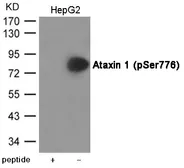APPLICATION
Application Note
*Optimal dilutions/concentrations should be determined by the researcher.
| Application |
Recommended Dilution |
| 1:500-1:1000 |
Not tested in other applications.
Calculated MW
Predict Reactivity
Mouse(>80% identity)
PROPERTIES
Form
Liquid
Buffer
PBS, 150mM NaCl, 50% Glycerol
Preservative
0.02% Sodium azide
Storage
Store as concentrated solution. Centrifuge briefly prior to opening vial. For short-term storage (1-2 weeks), store at 4ºC. For long-term storage, aliquot and store at -20ºC or below. Avoid multiple freeze-thaw cycles.
Concentration
1 mg/ml (Please refer to the vial label for the specific concentration.)
Antigen Species
Human
Immunogen
Peptide sequence around phosphorylation site of Serine 776 (R-W-S(p)-A-P) derived from human Ataxin 1.
Purification
Purified by antigen-affinity chromatography. Non-phospho specific antibodies were removed by chromatogramphy using non-phosphopeptide.
Conjugation
Unconjugated
Note
For laboratory research use only. Not for any clinical, therapeutic, or diagnostic use in humans or animals. Not for animal or human consumption.
Purchasers shall not, and agree not to enable third parties to, analyze, copy, reverse engineer or otherwise attempt to determine the structure or sequence of the product.
TARGET
Synonyms
ataxin 1 , ATX1 , D6S504E , SCA1
Cellular Localization
Cytoplasm,Nucleus
Background
The autosomal dominant cerebellar ataxias (ADCA) are a heterogeneous group of neurodegenerative disorders characterized by progressive degeneration of the cerebellum, brain stem and spinal cord. Clinically, ADCA has been divided into three groups: ADCA types I-III. ADCAI is genetically heterogeneous, with five genetic loci, designated spinocerebellar ataxia (SCA) 1, 2, 3, 4 and 6, being assigned to five different chromosomes. ADCAII, which always presents with retinal degeneration (SCA7), and ADCAIII often referred to as the `pure' cerebellar syndrome (SCA5), are most likely homogeneous disorders. Several SCA genes have been cloned and shown to contain CAG repeats in their coding regions. ADCA is caused by the expansion of the CAG repeats, producing an elongated polyglutamine tract in the corresponding protein. The expanded repeats are variable in size and unstable, usually increasing in size when transmitted to successive generations. The function of the ataxins is not known. This locus has been mapped to chromosome 6, and it has been determined that the diseased allele contains 40-83 CAG repeats, compared to 6-39 in the normal allele, and is associated with spinocerebellar ataxia type 1 (SCA1). Alternative splicing results in multiple transcript variants, with one variant encoding multiple distinct proteins, ATXN1 and Alt-ATXN1, due to the use of overlapping alternate reading frames. [provided by RefSeq, Nov 2017]
Database
Research Area
DATA IMAGES

|
GTX55421 WB Image
WB analysis of extracts from HepG2 cells using GTX55421 Ataxin 1 (phospho Ser776) antibody.
Left : Primary antibody pre-incubated with the antigen specific peptide
Right : Primary antibody
|
REFERENCE
There are currently no references for Ataxin 1 (phospho Ser776) antibody (GTX55421). Be the first to share your publications with this product.
REVIEW
There are currently no reviews for Ataxin 1 (phospho Ser776) antibody (GTX55421). Be the first to share your experience with this product.

